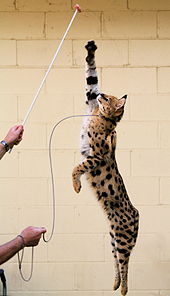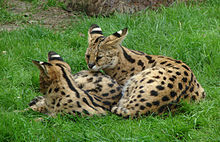Serval
| Serval | ||||||||||||
|---|---|---|---|---|---|---|---|---|---|---|---|---|

Serval |
||||||||||||
| Systematics | ||||||||||||
|
||||||||||||
| Scientific name of the genus | ||||||||||||
| Leptailurus | ||||||||||||
| Severzow , 1858 | ||||||||||||
| Scientific name of the species | ||||||||||||
| Leptailurus serval | ||||||||||||
| ( Schreber , 1776) |
The serval ( Leptailurus serval ) is a medium-sized wild cat of Africa , which is mostly spotted black on an ocher-yellow background. The name Serval probably comes from the Portuguese word lobo-cerval , which translates as lynx . It originated in the 18th century and can be found in this or a similar form in several European languages.
The total population of the serval is classified by the World Conservation Union IUCN in the Red List of Endangered Species as not endangered ( least concern ).
features
The serval reaches a body length of 70 to 100 cm and a shoulder height of 54 to 62 cm. In females the body weight is between 7 kg and 12 kg, in males between 9 kg and 18 kg. This makes it almost 20 centimeters taller than the South American ocelot , which has a similar body length, and about 12 centimeters higher than the caracal , which has a similar weight. It has a small head with large and round ears. Its legs are very long: no other species in the cat family has proportionally longer legs. In addition, the serval has a tail of medium length, reaching a length of up to forty centimeters, and the body is very slender.
The serval's spot pattern shows great individual differences. There are servals with very small spots, while others have large spots that merge in stripes on the neck and back. At the beginning of the 19th century, taxonomists considered it possible that the small and large-spotted servals were separate species. In the highland areas of East Africa, for example the Aberdare Mountains in Kenya, there are also completely black servals, which were also initially thought to be a separate species. Most of these melanistic servals have been sighted at altitudes between 2,440 and 2,745 meters.
Distribution area and habitat
The serval is found exclusively in Africa. It is still widespread south of the Sahara: it belongs to the fauna of most countries from Senegal in the west and Somalia in the east of Africa to the south of the Republic of South Africa. However, the serval has very specific demands on its habitat, so that it only inhabits individual regions in this distribution area. For example, it has become extinct in the South African Cape Province.
The serval was found in North Africa until recently. The last specimen was seen in Algeria in 1880. It is uncertain whether serval populations still exist in Morocco and Tunisia. The last confirmed sightings here are from the 1970s.
Servals inhabit different types of grasslands. Their occurrence is linked to the presence of water and vegetation made up of grass and reeds. They do not occur in deserts or semi-deserts, but they can survive where watercourses run through such arid regions. They can also inhabit forests, as long as the trees are sparse and are repeatedly broken through by clearings. However, servals are completely absent in the dense forest of equatorial West Africa. As long as water, food and cover are available, the respective microclimate and altitude do not seem to represent any restrictions for this type of cat. They have been observed at an altitude of 3000 m on the moors of the Aberdare National Park in Kenya. They are also found in the Kamberg Nature Reserve in the South African Midlands , where there are regular freezing temperatures in the African winter and occasionally even snow falls.
Way of life
Servals are sometimes referred to as nocturnal, but their pattern of activity is often influenced by both the presence of humans and the behavior of their prey. In regions where they have many large, nocturnal food competitors, they switch to other times of the day. In undisturbed areas of the Ngorongoro , the serval is mostly on the move in the early morning and late afternoon hours. During the night he goes on a short hunt every three hours. It usually rests in the shade during the hottest daytime temperature. These results were also confirmed by studies on six servals, whose activity patterns were examined in the Kamberg Nature Reserve with the help of radio transmitters. On hazy or cloudy days in particular, they would also hunt here during the day. In the Rustenburg Nature Reserve not far from the South African city of Rustenburg , however, the servals there were mostly nocturnal.
Investigations on the territorial behavior of servals are mainly available from the area of the Ngorongoro Crater. There, females have a territory of at least 9.5 square kilometers while those of the males are insignificantly larger with 11.6 square kilometers. The territories of females only overlapped slightly. Servals mark their territory with scent marks. A male observed in the Ngorongoro Crater left an average of 41 scent marks per hour over a period of 12 hours. In females, the behavior is somewhat less pronounced.
Food and way of hunting
With its high legs, the serval specializes in hunting small mammals in tall grass. Ninety percent of a serval's diet is made up of mammals, usually weighing less than 200 grams. In addition, the serval also hunts small birds, lizards, snakes, frogs and insects. In Zimbabwe , multi-teat mice weighing between 20 and 80 grams and the lamellar tooth rats weighing between 100 and 200 grams make up most of its prey. In Tanzania, in addition to lamellar tooth rats, the African harvest mouse, which weighs only about five grams, plays a larger role in its diet. When hunting, servals do not avoid the more humid areas of their territory and also hunt frogs and water birds. It has been observed that captive servals use their paws to fish fish out of the water. They also take larger prey such as hares, flamingos and young antelopes, but this is only an occasional prey.
Hunting servals usually run slowly through the grasslands, pausing again and again to listen for prey. Occasionally they sit down for long periods of time and wait until they hear a sound that indicates prey. Once they have localized the noise, they first approach carefully and then jump like a fox at the prey at a high leap. They try to grab the prey with one or both paws. If you don't catch the prey with the first jump, several quick stiff-legged jumps follow, during which the serval is in the air with all four paws. This is a characteristic of servals hunting. With their flexible paws, they are able to reach for rodents in burrows. They also occasionally dig to get to rodents that have fled into earthworks. A young male was also seen standing on its hind legs and trying to fish the nestlings out of swallow nests with its front paws. Snakes kill them by beating them with their paws or by biting them quickly several times. Younger servals in particular play with their prey before they eat it. When playing, they occasionally throw their prey in the air and catch it again.
Servals are also able to catch birds in the air because of their jumping abilities. They grab the flying birds with their front paws and then land only on their back paws. With a single jump, servals can cover a distance of 3.6 meters. They are said to be able to reach birds with their front paws, which are already three meters above the ground.
Females with juveniles look for food in a radius around their burrow, but they spend about twice as much time hunting as females without offspring. As the young animals get older, they use an increasing proportion of their territory to find food.
Reproduction
The serval lives basically solitary. Observations of several servals are either a short-term relationship while the female is in oestrus , or a mother with almost fully grown young.
A female serval's oestrus lasts anywhere from one to four days. Its beginning is accompanied by a change in behavior in the female, which then frequently meows briefly and sharply. This meowing can be heard from a greater distance. The gestation period for servals is around 74 days. The typical litter size are two pups, but litters with four pups have also been observed. Young animals are born in Africa all year round, but there is basically a temporal relationship between the breeding period of mice and servals. Servals give birth about a month before rodent reproduction is at its peak. In Ngorongoro Crater, September and November are typically the months when most servals are born. This is the end of the dry season. In Botswana, however, servals mainly throw their young during the rainy season.
Captive servals are capable of whelping three or four times a year if the young either die at birth or are taken away. In contrast, the shortest observed litter interval in servals raising their young was 184 days. This indicates that, under optimal conditions, servals are able to raise two litters within a year. However, this is the exception in the wild and one litter per year is the typical reproduction rate.
Newly born young animals weigh about 250 grams, their fur is a little grayer than the fur of adults. The young animals open their eyes between the 9th and 13th day of life. They start eating solid foods when they are around a month old. Young animals lose their milk teeth around six months of age and are able to hunt themselves shortly afterwards. They leave their mother's territory at around a year old.
Captive females were sexually mature at just over a year old.
Food competitors and predators
Servals especially avoid contact with hyenas. If you spot a hyena, crouch on the ground and wait. If the hyena approaches too closely, they flee with a series of further jumps, with the tail raised high. Servals also climb trees to avoid possible predators . Servals have few enemies, but are sometimes eaten by larger cats like leopards .
Servals live to be twenty years old in the zoo, and their lifespan in the wild is likely to be considerably shorter. It is estimated that they live to be an average of ten years old. Females probably raise between 16 and 20 young animals during this time.
Danger
The subspecies Berberserval has been pushed back by strong persecution in the heights of the Atlas , where it is now on the verge of extinction. The serval has also been exterminated in large parts of South Africa . Servals are considered common in the savannahs and grasslands south of the Sahara. In some regions where more and more grain is being grown and the rodent population has increased as a result, the environmental conditions for servals have even improved.
Servals are still hunted as they are seen as a potential predator for smaller pets. House poultry are particularly endangered.
Crossbreed with domestic cats
Servals can be crossed with domestic cats . The female offspring of these crosses are fertile, while the males of the first generation of crosses are usually sterile. The domestic cat breed Savannah was bred from such crosses in the USA in the 1990s . The Savannah is now a TICA recognized breed.
literature
- Mel Sunquist, Fiona Sunquist: Wild Cats of the World . The University of Chicago Press, Chicago 2002, ISBN 0-226-77999-8 .
- Christine Thiel: Ecology and population status of the Serval Leptailurus serval (SCHREBER, 1776) in Zambia . (Dissertation, University of Bonn, 2011). Bonn 2011, urn : nbn: de: hbz: 5N-25867 .
Web links
- Species profile Serval; IUCN / SSC Cat Specialist Group in English
- Leptailurus serval in the endangered Red List species the IUCN 2009 Posted by: C. Breitenmoser, P. Henschel, E. Sogbohossou, 2008. Accessed January 24 of 2010.
- Video: Acquiring prey from the serval . Institute for Scientific Film (IWF) 1990, made available by the Technical Information Library (TIB), doi : 10.3203 / IWF / Bio002 .






